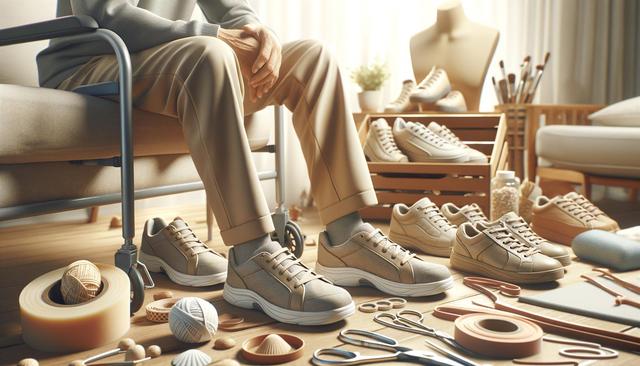Supportive Footwear for Seniors: The Role of Orthopedic Shoes in Everyday Comfort
Orthopedic shoes give foot care and help ease pain. Made for support, they fit well and aid those with foot, leg, or back issues. With soft insoles and firm base, they help you walk with more ease, less strain, and good form.

Understanding the Needs of Senior Feet
As we age, our feet undergo several changes that affect mobility and comfort. Seniors often experience reduced fat padding, decreased circulation, arthritis, or conditions such as bunions and plantar fasciitis. These changes can make walking painful and limit activity levels. Orthopedic shoes are designed to address these issues by providing enhanced support and cushioning that standard footwear may lack.
For seniors, the structure of the shoe plays a critical role. A stable heel counter, roomy toe box, and non-slip sole are just a few features that contribute to better balance and reduced risk of falls. Orthopedic shoes can also accommodate foot deformities or swelling, which are common among older adults. By prioritizing comfort and functionality, these shoes help maintain independence and improve quality of life.
Common foot problems addressed by orthopedic shoes include:
- Flat feet or fallen arches
- Diabetic foot complications
- Heel spurs
- Overpronation or supination
Each of these issues can benefit from the specialized design elements found in orthopedic footwear, making them a valuable option for seniors.
Key Features of Orthopedic Shoes for Seniors
Orthopedic shoes come with several built-in features that set them apart from regular shoes. These design elements are aimed at improving alignment, reducing pressure points, and enhancing mobility. Some of the most important features include:
- Removable insoles: Allow customization with orthotics
- Arch support: Helps maintain proper foot posture
- Shock-absorbing soles: Minimize impact on joints
- Adjustable closures: Offer a secure and flexible fit
- Breathable materials: Keep feet cool and dry
These features work together to create a shoe that not only feels good to wear but also provides long-term benefits. Whether walking around the house or heading out for errands, wearing the right orthopedic shoes can make a noticeable difference in daily comfort and foot health.
For seniors with specific medical conditions, orthopedic shoes may also be prescribed by healthcare providers. This ensures the footwear meets the individual’s needs and complements other treatments or therapies they may be undergoing.
Choosing the Right Pair
Selecting the right orthopedic shoes involves more than just picking a size. Seniors should consider their specific foot issues, the intended use of the footwear, and personal preferences in style and fit. Visiting a specialist or a store that offers professional fitting services can be extremely helpful.
When shopping for orthopedic shoes, it’s important to:
- Ensure a proper fit by trying shoes on later in the day when feet are most swollen
- Look for shoes with easy-to-use closures like Velcro or zippers
- Test the heel and arch support for adequate stability
- Check for return or exchange policies in case the fit is not right
The right pair should feel supportive but not restrictive. It’s crucial that the shoes accommodate any foot irregularities without causing additional discomfort. Seniors who are active may benefit from different styles than those who need shoes primarily for indoor use.
Comfort should never be sacrificed for appearance, but fortunately, many orthopedic shoe designs now offer both functionality and appealing aesthetics, making it easier to find a pair that suits personal tastes.
Benefits Beyond Foot Health
Wearing orthopedic shoes can have positive effects that extend beyond the feet. Proper footwear contributes to better posture and can alleviate pain in the knees, hips, and lower back. For seniors, this can lead to improved balance, reduced fatigue, and a lower risk of falls—a major concern in aging populations.
Increased mobility from wearing supportive shoes often leads to more physical activity, which benefits overall health. Regular movement supports cardiovascular health, joint flexibility, and mental well-being. Seniors who feel comfortable on their feet are more likely to stay engaged in social activities and maintain an active lifestyle.
Some of the broader benefits include:
- Reduced joint strain during walking
- Improved circulation in the lower extremities
- Enhanced independence and confidence
- Better alignment of the spine and hips
All these factors contribute to a higher quality of life, making orthopedic shoes a worthwhile consideration for any senior prioritizing health and comfort.
Care and Maintenance Tips
Once a suitable pair of orthopedic shoes has been found, taking care of them is essential to ensure their longevity and continued effectiveness. Proper care not only preserves the structure of the shoe but also maintains hygiene and comfort.
Here are some useful maintenance tips:
- Clean shoes regularly using a soft brush or damp cloth
- Air them out after each use to prevent odor buildup
- Rotate between two pairs to allow time for each to breathe
- Replace insoles as needed, especially if they show signs of wear
- Store in a cool, dry place to prevent deformation
It’s also wise to periodically check the soles and insoles for signs of uneven wear, which may indicate changes in gait or posture. In such cases, consulting a healthcare provider or a podiatrist can help reassess footwear needs and make adjustments as necessary.
With consistent care, orthopedic shoes can continue providing the support and comfort seniors need to stay active and pain-free.
Conclusion: Supporting Mobility and Comfort in Later Life
Orthopedic shoes offer meaningful benefits for seniors seeking comfort, stability, and improved mobility. With thoughtful design, these shoes address common age-related foot issues and contribute to overall well-being. Choosing the right pair, incorporating them into daily routines, and caring for them properly can make a significant difference in quality of life. Whether dealing with chronic conditions or simply aiming to stay active, seniors can greatly benefit from footwear that supports both their feet and their lifestyle.